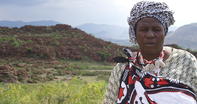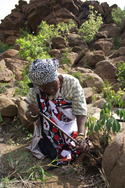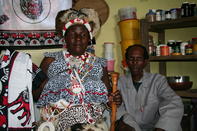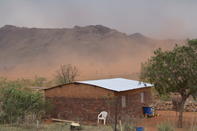Old Meets New
This is a story about a borehole. Well, it's about more than that, but it starts with a borehole and a power line and a message from the ancestors. And the message isn't good. But it's also a story about survival in a world where the rains bring plenty today but retreat tomorrow, leaving the sorghum and morogo for dead.

It's about a place where the "drastic" disease slinks quietly through villages; where jobs are as precious as the platinum seams which lure miners from far-off places; where the child of a chief talks about a Ferrari but probably knows he may never even own a jalopy. Unfolding amidst the chunky koppies in the nouveau mining frontier near Burgersfort in the Limpopo bushveld is a subtext that is as delicate as it is complex.
For it takes place in that indefinable place where old meets new; where traditional African culture melts into Western ways; it is where the ancestors and the Christians circle one another uncertainty. That place - that space where such different realms meet - is a restless filament, one which never quite comes into focus. One can never be sure if they meet awkwardly like oil and water or blend seamlessly and invisibly into comfortable solution.
A Modern Sangoma

Set against the Cubist-like tumbles of blood-brown igneous boulders, where the flaking white-green roots of muscular young fig trees try to strangle their rocky foundation, is the home of this story's protagonist.
A sangoma. Selina Thotse was a dressmaker and knitter until a prophet in her Zionist church told her that her path was with the ancestors. Her obedience to the calling got her expelled from that very church, but she has prospered from it, nevertheless, albeit marginally.
Her first cow was in payment for a protection spell over someone's home, a "preservation of premises" she calls it. Now she has three cattle. Her first goat was bartered for a jersey and a breeding pair of pigs was for healing someone down on the plains.
The Modern Age

She now resides as matriarch over a gaggle of children, since her ageing husband no longer works: five of her own children (another two have already left home), along with several nieces and nephews, and a few orphaned children from the community.
While the bustling Thotse homestead is far from wealthy, things are a bit better off these days, what with her income as a healer, her pension and the orphans' grants from the state. This is the age of the modern sangoma, who dons surgical gloves before administering coal-coloured ash into the fine cuts she has made in the skin of a screaming infant.
A cell phone call sets the next appointment to throw the bones for someone. Plastic beads occasionally replace glass in the healer's garb. The elaborate reburial of the remains of a great-great-grandfather - with the ceremonial spitting of frothing sorghum beer and snorting of tobacco snuff - all captured on home video.
Rows and rows of mysterious dried muti sealed in recycled Purity bottles or discarded Ricoffy tins.
Water Needed for Survival

But let us return to that troublesome borehole. In April 2007, Selina Thotse had a borehole sunk into her backyard, an extraordinary achievement for so poor a community. At first, it struck water but then the borehole stopped delivering.
Selina blames the electricity. It's not powerful enough to drive the pump that sucks water up from the belly of the Earth, she says, a sign that the ancestors are unhappy with the presence of this modern thing, electricity, in their enclave.
So her children settle for the tedium of carrying water in daily from the nearest water point 1.5 km away, and Selina ensures that nothing, not even a light bulb, draws current into any rooms where she communes with the ancestors. Water is the pivot around which the survival of a rural village like Ga-Selala turns.
Most houses are bricks and mortar. Many have electricity, but water and sanitation have yet to reach into these homes. In the past, the sole water points were a few wells in the village.
Today, these are gloomy and dirt-slicked pools encircled by the strangely urban signature of graffitied concrete. Now water is piped down from a small dam to standpipes dotted about the village. As long as there's money to buy fuel to run the pump which pushes groundwater to the dam, gravity does the rest.
Just Enough
But there's only just enough water to get by, just enough for basic domestic needs: drinking, cooking, cleaning. Most of the district's rain falls between November and March and, compared with the national average of 450 mm per year, the Ga-Selala area receives between about 500 mm and 600 mm of rain annually.
The problem is that the rain arrives inconsistently, one year will bring plenty, another will not. Summertime temperatures reach as much as 38°C with the accompanying heat stress and evaporation. Many villagers have tried to grow their own vegetables in the past, but if the cumulus clouds withhold their summer rains just when the crops need them most in the growing season, the crops fail.
The groundwater isn't accessible enough to feed to crops. One year, during a particularly dry spell, the village committee banned the irrigation of any vegetable gardens.What little water they had, explains tribal authority secretary Herbert Mahlahla during a stroll through the village, had to be reserved for domestic use. Besides, the hours of toiling between a garden and the nearest communal tap would probably exhaust many, particularly those with failing health.